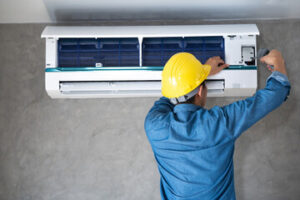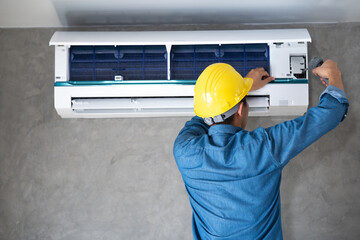For safety reasons, it’s important to shut off power to the air conditioner before you begin working on maintenance tasks. You can do this on the exterior unit with an external shut-off box or at your breaker box inside your home.
Moisture buildup from a clogged condensation line can damage ductwork and insulation in your home. Cleaning it is a simple but vital AC maintenance task. You can hire a professional Hubbard Mechanical air conditioning expert to do the job for you.

Check The Thermostat
Keeping your thermostat in good working condition is crucial to the proper operation of your air conditioning system. If you notice that the temperature in your home isn’t getting as cool as it used to, or if the system keeps turning itself on and off, there may be a problem with your thermostat.
First, make sure the thermostat switch is in the on position and that it’s set to “cool” or “AC.” Then check to see if any override programs are engaged. Also, make sure the batteries are in good shape or replace them if needed.
Older mechanical thermostats can suffer from dust buildup and corrosion. If you have one of these, enlist the help of a friend to hold it while you remove the faceplate and clean it thoroughly. If yours is a digital model, consult its owner’s manual to verify the correct settings and troubleshooting instructions.
If you have a two-wire thermostat, it’s relatively easy to test for correct voltage with a multimeter. Turn off the power to your home’s furnace and remove the thermostat cover to expose the wires. Then touch the probes of your multimeter to each of the wires connected to the thermostat body. If your meter reads 24 volts AC, the thermostat is connected correctly.
If the voltmeter does not read any voltage, you will need to take the thermostat apart to determine if the bimetallic element is bad or if it has simply burned out. Then you can replace it or contact a professional for further assistance.
A multimeter is an inexpensive tool that can be very useful for testing many electrical circuits. If you are not experienced in using one, however, we recommend consulting an expert before trying to repair or replace a thermostat. Having an experienced professional perform an inspection, check-up, or tune-up is the best way to ensure that your HVAC equipment functions properly. An experienced technician can quickly identify the problem and fix it before it becomes worse. They can also help you maintain your equipment with tips for proper maintenance and repair.
Clean The Evaporator
A dirty evaporator coil will restrict airflow through the system, causing the equipment to work harder than it should and possibly shortening its lifespan. You can help prevent this by regularly cleaning the coils inside your home.
This task is easier than it sounds. First, you’ll want to make sure that the unit is turned off before you begin. You can do this by turning off the power at either the thermostat, a switch near the outdoor unit, or at the breaker box.
Next, locate the evaporator coils. These are usually located on top of the air handler in your basement, closet, or attic. Look for a removable access panel held in place by screws or tape. Remove the panel and use a nylon brush to clean any dust off the coils. Then rinse the coils using a garden hose (NOT a power washer; too much pressure can bend or damage the delicate fins). Be sure to clean the access panel and screw it back in place afterward.
If the coils are heavily soiled, it’s best to leave this task to a licensed Carrier indoor comfort specialist. They’ll turn off the system at the thermostat or switch or at the power cutoff near the outdoor unit, then remove and inspect the evaporator coils for any debris like leaves or flowers that may have clung to them. They’ll also inspect the condensate drain for any blockages.
Then they’ll apply a commercial cleaner to the coils and allow it to sit and foam until both the dirt and the cleaner are drained away. Finally, they’ll wipe down the coils with a soft cloth.
In addition to this maintenance, it’s important to keep the area surrounding your outdoor unit free of obstructions. Trim any shrubs or flower beds that may restrict the airflow around the unit and regularly sweep away the grass clippings, leaves, and other debris. Make sure that there’s a clear 12 inches of space between your AC unit and any trees or shrubs. Also check the ground level regularly to ensure that it doesn’t shift, as this could cause the unit to become unbalanced and prone to breakage or even separation from your house.
Clean The Condenser
One of the most important parts of your air conditioning maintenance routine is cleaning the condenser. This part of your system is located outside for central and window units, or inside the machine for portable units. Condenser coils are the most important parts of an AC unit, and a clean condenser helps to ensure proper operation and efficiency.
Before you begin cleaning the coils, be sure that the power to the unit is shut off. This can be done either by turning off the circuit breaker that corresponds to your AC in your home’s breaker box or by switching off the power at the disconnect switch near your outdoor unit (this may have a lever, a switch, or a fuse block that you can pull out to shut off the power). Always wear rubber gloves while working on electrical connections.
Next, you need to gather a few tools for the job. This includes a shop vacuum, a pump-up garden sprayer with a fine or wide spray attachment and a coil cleaning solution concentrate, a brush for removing large chunks of dirt, a garden hose, and a fin comb (available at most hardware stores). It is also helpful to have some pruning shears handy if any plants are growing too close to the unit and need to be cut back.
Once you’ve gathered your tools, start by removing the fan from the unit if possible. This will allow you to access the coils more easily and can save you a lot of work. It’s also a good idea to remove any debris around the unit until there are two feet of clearance all the way around.
With the fan removed, you can start to clean the condenser coil. This should be done with a brush or a vacuum that has a brush attachment to remove the larger pieces of dirt and dust. Then, use the sprayer to rinse the coils and the fins with water. Be sure to keep the pressure low and avoid direct contact with the fins, as they can easily be bent or crushed.
Check The Filters
An air conditioning system has a filter that acts as the first point of contact for the air that passes through it. This is an essential function that helps to keep dust, hair, and other contaminants from reaching different parts of the unit, thus ensuring proper operation. Over time, the filter can accumulate a significant amount of this debris, causing problems that are easy to prevent with regular maintenance.
In general, it is recommended that the filter be changed at least once every three months, but this can vary depending on several factors such as whether you have pets in your home and the type of filter you use. To ensure that the filter is replaced on time, it is a good idea to put a reminder in your calendar or on an app such as your phone’s day planner.
Before you change the filter, make sure that the power to the air conditioner is turned off. This is to prevent the risk of touching live voltage or having any other debris sucked into the unit. Next, you should remove the old filter and clean the slot where it was placed before inserting the new one. Finally, you should check that the arrow on the filter frame points away from the return air duct and toward the air handler cabinet.
A professional can help you choose the right filter for your needs and provide advice on how often you should change it. For example, some filters have a MERV rating that indicates how effective they are at trapping airborne particles, with the higher ratings providing better filtration.
In addition to checking the filter, you should also make sure that the evaporator coil and the condenser are free of any dirt or debris. It is a good idea to clean these areas before summer arrives so that you don’t have to worry about them when you’re trying to enjoy the warm weather. Finally, you should always be careful to keep plants, weeds, and other vegetation at least 18 inches away from the outdoor unit. This will help to prevent them from getting sucked into the condenser, which could result in a costly repair bill for your HVAC system.
